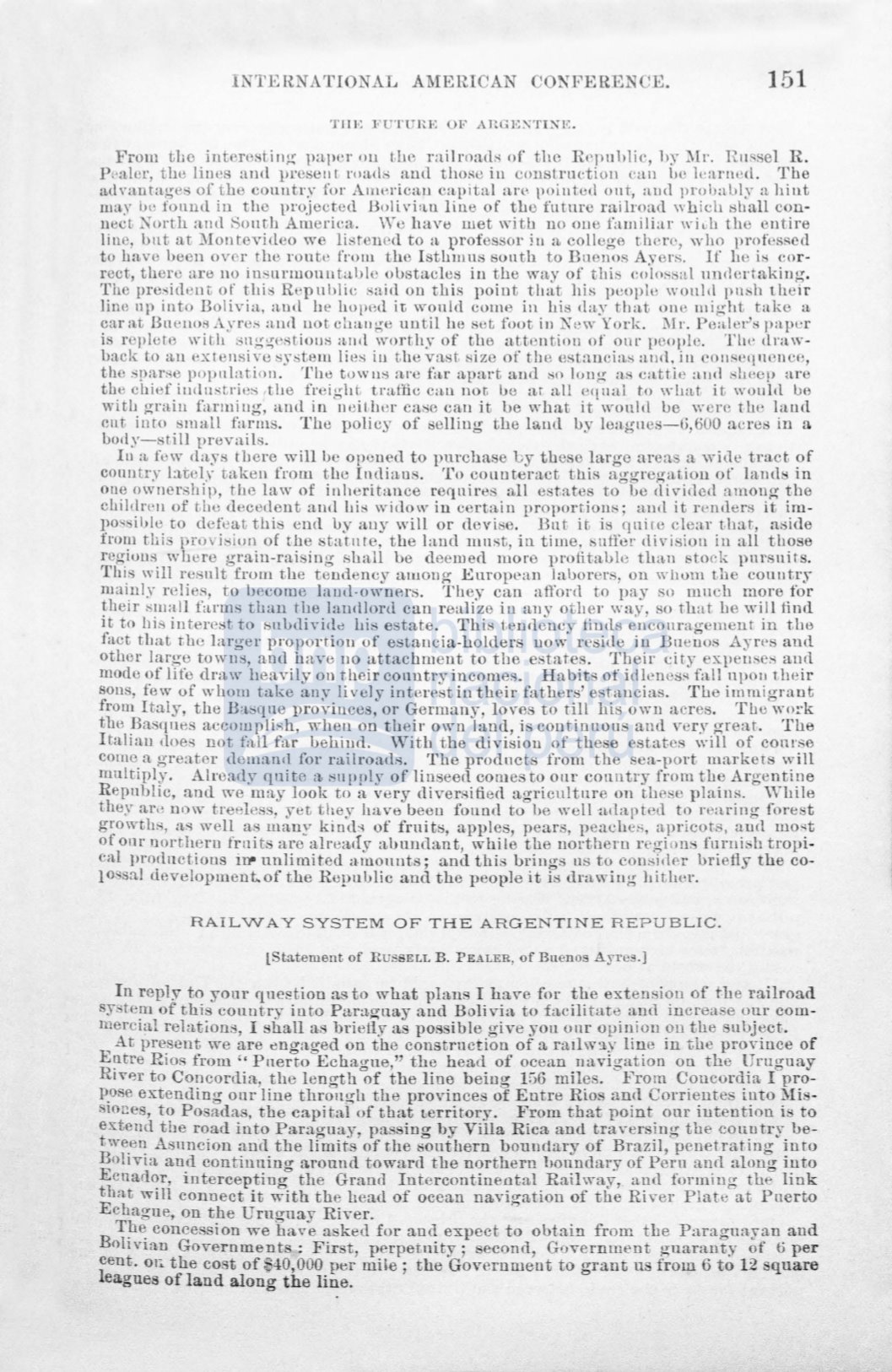

INTERNATIONAL AMERICAN CONFERENCE.
151
T Ja;
l<'UTUJ~E
OF ARGEXTI::-/E.
From tbe interesting paper
•111
Lhe railroa,cb
qf
thc R epuhl ic,
h;-,~
l\lr. R nssel R .
p ¡•alcr, the lines a nd prc:sen r r11:1ds auu tbose in eunstruction can
\;e h·arnecl.
Tbe
ad,·antages of the conutr.'· for American capital are poi uted
011t,
aud]HObalJl~-
a hiut
ma~'
lw fonnd in the projectecl Bolivi:tn liue of the futnre railroad wbich Hhall con–
uect Xorth am1 Son th Aruerica.
\Ve
have wet witb n o one familiar wiLh the e nt ire
liue, but at )fon tevi deo we listened toa professor iu a college Lbcre, who professcd
to b:we been ovcr the routc from tlle Istbmus sonth to Bueno. Avers.
lf
be is cor–
rect, t herc are no insurmonutahle oustacles in the way of this co.los::;alnnclcrtaking.
Tlle pre:;iclent of this Rep nbli0 ::;ai<1 oo this point tltat hi;; people wonld pn ·b the ir
Jine np into Bolivia, <tull he hoped it wonld come in bis day that one might take a
car at Bnenos.Ayre:; a.nrl uot cl.HLtt ge until he set foot in New York. i\Ir. P e:del"s paper
is r eplete with
::mg~estiow.;
an•l worthy of the attentiou
or
our pco plc. Tlie draw–
back to au extensives,p;tem líe::; iu t heva,:;t. size of tbe estanci:u; :Lild, in collseqncnce,
the sparse populatiou . Tlle t uwn:; are far apart and :;o luug as catti e all(l ·hpep a re
tbe cbief iut1n:strics the freigltt tr:offie can not ue ar all eqnai to wilat i t
\YOtlld
be
witb graiu farmiug, anu in neit,her case can it be what it woultl ue werc the laucl
cnt into small f:Lrm . Thu policy of selliug the laucl by lengnes- G,600 a cres in a
Lod y-still prevai ls.
Iu a fcw days there will be opcned to purchase by tbese large urea a "\Yit1e tract of
conntry btely taken froru tlle Indiaus. To conoteract this aggreg ation of lanü::; in
one ownership, tbe law of inheritauce requires all e:states to be dividetl nmoug tbe
children of tbe decedeut and lJis witlo w in certain proportions; aucl it r en llers it im–
JlO~:,;ible
to defeat tbis encl uy auy
,,.¡u
or de,rise. But i t is quire cle:-tr that, aside
from tl1is
pr<J
j:;iun of tbe statnte, tbe land mnst, in time, sntfur tlivision iu all those
regiuns wbere g rain-raising sball ue deemed more profi.tal..Jlc tlmn stock pursnits.
This will resnlt from the teudency amoug .European lauorers, on wll om tbe country
mainly relies, to l.Jecome lauu.owners. They can affon1 to pay so mnch more for
~heir
:;mall f<Lrms than the ln.ntllord can re:Llize i n any otl1er way, so tbat be will tind
1t to Iris iuterest to ::;nudividtl bis estate. This tenf1eucy iiutls enconragement in the
fact tl1at tbc larger proportion of estancia-bolders uow reside iu Bneuos Ayrt>s aucl
other large towus, and n ave no attachmeot to the estates. Their t; it y expeuses aud
mode of life draw heavily on t beir conntryincorues. Habits of idlenes,. f<tll nporr rheir
sous, few of whom take any lively interest in their fathers' estan cias. Tbe immi<Yrant
from It:1ly, the
B<~.sq ne
provinces, or Gerruany, love to till his own acres. Tue
\nl~·k
tbe Bas<1nes accoruplisb, when on th eir own lancl, is coutinnous and very great. The
I talian tloes not
fa.llfar uehiurl. With t he divisiou of these estatcs
will
of conrse
come a g reater demantl for railroatls. Tbe proclncts from tbe sea-port m::trkets will
nmltiply. Alread.v <l_uite a ::;npply of linseecl comesto onr conntry from tbe Argentine
Repnblic, and we may look toa very diversified agricultnre on tlH•::;e
plain~.
\Vhile
they
ltr<J
n•)w t reeless, yeL they
lw.vebeeu fonutl to be well -adapteü to rearmg fore t
growths, as well as manr kintb of frnits, apples, pears, peaches,
n.pricots, aud moRt
of Olll' Dorthern frnits are already abnndant, whi le the northern regions furuish tropi–
cal pro<lnct ions
ill"
unlimited a.tuonnts; and thi brings us to consitle:r briefiy the co–
JO~sal
development.ofthe Republic aud the peop1e it is drawiug h itlwr.
RAIL"W'AY SYSTEM OF THE ARGENTINE REPUBLIC.
[Statement of
RUSSELI,
B.
PEALER,
of Buenos Ayres.]
In r eply to your q
ne~;;tion
asto what plans I ll:tve for the extension of the ntilroad
system of this country into Par:1gnay and Bolivia to faeili tat e and
increa~e
our com–
mercial re1a.tion::;, I shall as briefi.v as possible give you onr opinion ou the subject..
At preseut we are ollO':tcred on the construetion of a ra1lw:1y line in the proviuce of
Entre R íos from 'Pnerto"'Ecbague," the head of ocean navigation ou the l rugnay
R1v~r
to Concordia, the length of tbe line beiog
l~l6
mile . l?rom Concordia I pro–
P.ose extending our line thron,gll th e provinces of Entre Rios aml Corrientes iuto Mis–
.tol.!es, to Posadas, tbe capital of that territory. From tbat point our iuteution is to
extend the road into Paraguay, passing by Villa Rica and traYersing the couutry be–
tween Asnncion and tbe limits of the southern boundary of Brazil, penetrating into
Bolivia and contiuuing around toward tbe nortbern honndary of Peru ancl aloug iuto
E cuador, intercepting the Granel Intercontinental Railway, aud forming the link
tba.t will connect it with the hcad of ocean navigation of the River Plate at Puerto
Echan-ue, on the Uruguay River.
T?~
concession we have asked for and ex:pect to ol>t:ún from t be Paragnn.yan and
Bohnan Governments : First, perpetnity; second, Government guara.nty of
ti
per
cent.
01~
the cost of
~40,000
per mile; the Government to grant us from 6 to 12 qnare
leagues of land along the line.
















